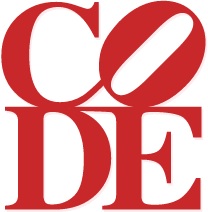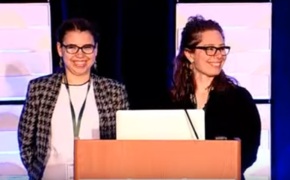Last week I attended my first annual Code4Lib meeting in Philadelphia. Code4Lib started in 2003 as a mailing list and has since grown to a thriving community of hackers, cataloguers, designers, developers, librarians and even archivists. This year was the 11th annual conference and there was a significant online presence, including an IRC, slack channel, and the hashtag #c4l16. All presentations and lightning talks from the conference were streamed live and the videos are still available on the Code4Lib YouTube channel.

Code4Lib 2016 Annual Conference logo
The week started off with a day of pre-conference workshops. I attended the Code4Arc workshop which focused on how coding and tech is used slightly differently in the archives world. Since archives have different goals and use different descriptive standards it makes sense to carve out a space exclusive to archival concerns. One common interest was in how multiple tools are connected when they’re implemented in the same archive. Many attendees were implementing ArchivesSpace to handle archival descriptions and were concerned about interoperability with other tools. Another concern was regarding the processing and management of hybrid collections, which contain both analog and digital material. Digital is often addressed as completely separate from analog, but many collections come into the archive containing both and that relationship must be maintained. Archivists in the workshop called for tools to be inclusive of both digital and analog holdings, especially in regards to processing and description.
I joined NDSR-NYC alum Shira Peltzman to kick-off the presentation part of the conference with a discussion of Implementing ‘Good Enough’ Digital Preservation (video here). The goal of our presentation was to make digital preservation attainable, even for those with limited support. We began with a brief overview of the three tenets of digital preservation – bit preservation, content accessibility, and ongoing management- before diving into specific resources and strategies for implementing good enough digital

Shira and myself presenting on “Good Enough” Digital Preservation
preservation. We defined ‘good enough’ as the most you can do with what you have – based on available staff and budget, collection needs, and institutional priorities. The main offerings from our presentation were expansions on the NDSA Levels of Digital Preservation. We mapped each recommendation to useful tools, resources and policy recommendations based on our experience in NDSR and beyond. We also proposed an additional level to address the access issues related to digital preservation, such as redaction of personal information and making finding aids publicly accessible. Since the NDSA levels are such a common tool for getting started with digital preservation, we hope that these additions will make it easier to move to the next level – no matter what level you are currently at.
Our talk ended with a call for engagement with our NDSA level additions and more generally, to share policies and workflows with the community. The call for shared documentation was a common thread through many presentations at the conference. Dinah Handel and Ashley Blewer also discussed this in their talk “Free Your Workflows (and the rest will follow)” (video here). They made a great point about why people don’t share their documentation – because it’s scary! There’s the constant battle against imposter syndrome, fear of public failure, not to mention the fear that as soon as a policy is polished enough to share widely it is also outdated. All of these are very real reasons to hesitate, but the advantages that come from shared documentation severely outweigh these reasons. And nowhere is this more true than in the realm of open source solutions. Open source projects often rely on the community to notify them of bugs and help create complete and accessible documentation. Shared policies and workflows help to build that community, and help the field understand how tools and strategies are actually implemented.
If you are reading this and thinking – I have documentation that I could share but where would I put it? Worry not! There are a few great places for sharing open documents.
Scalable Preservation Environments (SCAPE) collects published digital preservation policies
Library Workflow Exchange collects all library-related workflows, including digital preservation.
Community Owned digital Preservation Tool Registry (COPTR) is a wiki for all digital preservation tools, and provides a space for users to present their experiences with any given tool. This information is automatically pushed to the interactive tool grid created by Preserving digital Objects With Restricted Resources (POWRR).
Github is known as a repository for code, but it can also be a great storage option for workflows and documentation. It is especially useful for managing version control for live documents.
Do you know of another place to share digital preservation documentation? Let us know in the comments!